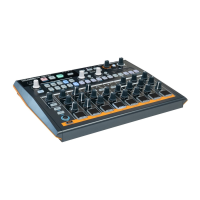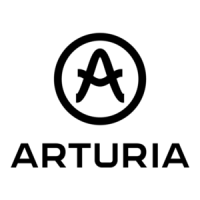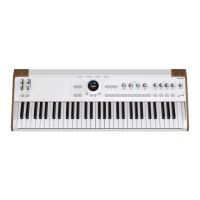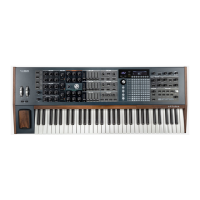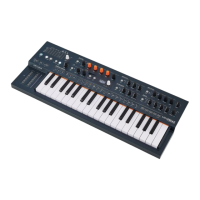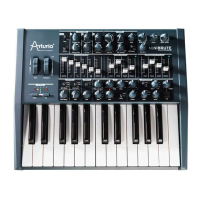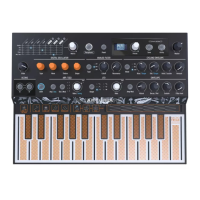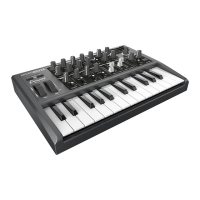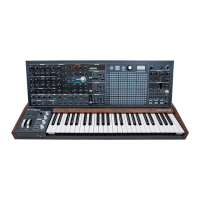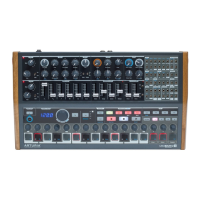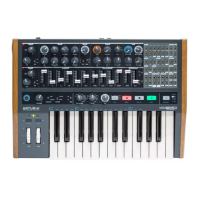Do you have a question about the Arturia DrumBrute and is the answer not in the manual?
Information in the manual is subject to change without notice.
Key warnings, notices, and precautions regarding safe product operation.
Welcomes the user and introduces the DrumBrute's analog sound and modern integration.
Details how to connect the DrumBrute to computers and external MIDI devices.
Explains tempo display, tempo setting, transport buttons, sync options, and modes.
Controls for output filters, master volume, and pattern effects like Swing and Randomness.
Details instrument controls, select buttons, and the function of the 12 pads.
How to use the metronome, mute/solo functions, and the shift button for secondary controls.
Details the power, USB, MIDI, and Clock input/output ports.
Details individual outputs, metronome output, mix output, and headphone connections.
Explains how to select banks and patterns on the DrumBrute.
Details how to set the tempo for patterns and songs using various methods.
How to activate and configure the built-in metronome for practice.
Guides users through the process of recording new drum patterns.
Instructions on how to save created patterns to the device's memory.
Explores output filters, Swing, and Randomness for pattern experimentation.
Using the touch strip for real-time rolls, loops, and step repeats.
Details the behavior of the Play/Pause button via MIDI Control Center settings.
How to send an All Notes Off command to stop stuck notes.
Explains the concept of songs as sequences of patterns.
How to choose and navigate between songs on the DrumBrute.
Step-by-step guide to building songs by sequencing patterns.
Instructions for saving newly created songs.
How to delete existing songs to make space or start fresh.
Features unaffected by song loops or bank shifts, like Output Filter, Looper/Roller, and Pause/Restart.
Includes Tempo, Swing, and Randomness settings that are embedded within patterns and may reset.
Guides on creating new drum patterns, covering tempo, time division, recording, and basic editing.
Details on mute/solo, roller, spot erase, and pattern length adjustments.
Adjusting rhythmic feel with Swing and introducing unpredictability with Randomness.
Editing individual steps and accent velocities within patterns.
Understanding LED states and selecting drums for editing within the pattern.
Using Step Repeat for fills and adjusting event timing for groove.
Procedures for copying instrument tracks and erasing pattern data.
Setting pattern length, editing steps 17-32, and saving patterns.
Method for copying patterns to different locations within the same bank.
Procedures for copying all 16 patterns from one bank to another.
Steps for copying patterns within or between different banks.
Procedures for copying instrument tracks between patterns and banks.
How to delete all patterns within a specific bank.
Instructions for deleting a single pattern from a bank.
How to remove an instrument track from a pattern.
Methods for lengthening patterns by adding steps or copying data.
Procedure for reducing the length of patterns.
Explains the concept of using different time signatures for individual instrument tracks.
Step-by-step guide to creating polyrhythmic patterns.
A reference table detailing all Shift button functions and their effects.
How to configure the DrumBrute to act as the master clock for MIDI synchronization.
How the DrumBrute syncs with external clock sources as a slave device.
Introduction, system requirements, installation, and connecting DrumBrute.
Basic functions like drag-and-drop, storing/recalling, and template management.
Navigating projects, revising templates, and sending patterns to the DrumBrute.
Storing/recalling data, saving/deleting files, and importing/exporting settings.
Data entry, tab selection, bank tabs, and device settings tab usage.
Navigating pattern views, setting length, and editing individual pattern events.
Setting track-specific Swing/Randomness and configuring Polyrhythm.
Configuring MIDI channel, global settings, sync, tempo, and pad behavior.
Configuring local control, roller/looper, transport, and drum map settings.
Information in the manual is subject to change without notice.
Key warnings, notices, and precautions regarding safe product operation.
Welcomes the user and introduces the DrumBrute's analog sound and modern integration.
Details how to connect the DrumBrute to computers and external MIDI devices.
Explains tempo display, tempo setting, transport buttons, sync options, and modes.
Controls for output filters, master volume, and pattern effects like Swing and Randomness.
Details instrument controls, select buttons, and the function of the 12 pads.
How to use the metronome, mute/solo functions, and the shift button for secondary controls.
Details the power, USB, MIDI, and Clock input/output ports.
Details individual outputs, metronome output, mix output, and headphone connections.
Explains how to select banks and patterns on the DrumBrute.
Details how to set the tempo for patterns and songs using various methods.
How to activate and configure the built-in metronome for practice.
Guides users through the process of recording new drum patterns.
Instructions on how to save created patterns to the device's memory.
Explores output filters, Swing, and Randomness for pattern experimentation.
Using the touch strip for real-time rolls, loops, and step repeats.
Details the behavior of the Play/Pause button via MIDI Control Center settings.
How to send an All Notes Off command to stop stuck notes.
Explains the concept of songs as sequences of patterns.
How to choose and navigate between songs on the DrumBrute.
Step-by-step guide to building songs by sequencing patterns.
Instructions for saving newly created songs.
How to delete existing songs to make space or start fresh.
Features unaffected by song loops or bank shifts, like Output Filter, Looper/Roller, and Pause/Restart.
Includes Tempo, Swing, and Randomness settings that are embedded within patterns and may reset.
Guides on creating new drum patterns, covering tempo, time division, recording, and basic editing.
Details on mute/solo, roller, spot erase, and pattern length adjustments.
Adjusting rhythmic feel with Swing and introducing unpredictability with Randomness.
Editing individual steps and accent velocities within patterns.
Understanding LED states and selecting drums for editing within the pattern.
Using Step Repeat for fills and adjusting event timing for groove.
Procedures for copying instrument tracks and erasing pattern data.
Setting pattern length, editing steps 17-32, and saving patterns.
Method for copying patterns to different locations within the same bank.
Procedures for copying all 16 patterns from one bank to another.
Steps for copying patterns within or between different banks.
Procedures for copying instrument tracks between patterns and banks.
How to delete all patterns within a specific bank.
Instructions for deleting a single pattern from a bank.
How to remove an instrument track from a pattern.
Methods for lengthening patterns by adding steps or copying data.
Procedure for reducing the length of patterns.
Explains the concept of using different time signatures for individual instrument tracks.
Step-by-step guide to creating polyrhythmic patterns.
A reference table detailing all Shift button functions and their effects.
How to configure the DrumBrute to act as the master clock for MIDI synchronization.
How the DrumBrute syncs with external clock sources as a slave device.
Introduction, system requirements, installation, and connecting DrumBrute.
Basic functions like drag-and-drop, storing/recalling, and template management.
Navigating projects, revising templates, and sending patterns to the DrumBrute.
Storing/recalling data, saving/deleting files, and importing/exporting settings.
Data entry, tab selection, bank tabs, and device settings tab usage.
Navigating pattern views, setting length, and editing individual pattern events.
Setting track-specific Swing/Randomness and configuring Polyrhythm.
Configuring MIDI channel, global settings, sync, tempo, and pad behavior.
Configuring local control, roller/looper, transport, and drum map settings.
| Hot keys | Yes |
|---|---|
| Product type | Analog synthesizer |
| Product color | Black |
| Sound effects | Filtering |
| Number of pads | 12 |
| Volume control | Rotary |
| Backlight color | Various |
| Keyboard number of keys | - |
| USB ports quantity | 1 |
| Card reader integrated | No |
| Power source type | AC |
| Depth | 276 mm |
|---|---|
| Width | 418 mm |
| Height | 40 mm |
| Weight | 2580 g |
